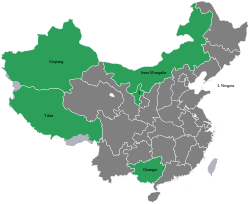Top Qs
Timeline
Chat
Perspective
Autonomous regions of China
From Wikipedia, the free encyclopedia
Remove ads
The autonomous regions (Chinese: 自治区; pinyin: Zìzhìqū; lit. 'self-governing area') are one of the four types of province-level divisions in the People's Republic of China. Like provinces, an autonomous region has its own local government, but under the law of the People's Republic of China, an autonomous region has more legislative rights, such as the right to "formulate self-government regulations and other separate regulations."[1] An autonomous region is the highest level of minority autonomous entity in China, which has a comparably higher population of a particular minority ethnic group.
This article needs additional citations for verification. (October 2018) |
There are five autonomous regions in China: Guangxi, Inner Mongolia (Nei Menggu), Ningxia, Tibet (Xizang), and Xinjiang.
Remove ads
History
Established in 1947, the Inner Mongolia Autonomous Region became the first autonomous region in the Chinese liberated zone. Xinjiang was made autonomous in 1955 after the PRC's founding, and Guangxi and Ningxia were made autonomous in 1958. Tibet was annexed by the People's Republic of China in 1951, and was declared an autonomous region in 1965. The designation of Guangxi and Ningxia as Zhuang and Hui autonomous areas, respectively, was protested by the local Han Chinese, who made up two-thirds of the population of each region.[citation needed] Although Mongols made up an even smaller percentage of Inner Mongolia than either of these, the ensuing Chinese Civil War gave little opportunity for protest.[2]
Remove ads
Legal rights
Autonomous regions in China have no legal right to secede, unlike in the Soviet Union – the Law of the People's Republic of China on Regional Ethnic Autonomy, written in 1984, states that "each and every ethnic autonomous region is an inseparable part of the People's Republic of China," and that "any form of ... separatism ... is absolutely prohibited."[3][4][5]
Public goods and services
In general, China's minority regions have some of the highest per capita government spending on education, among other public goods and services.[6]: 366 Providing public goods and services in these areas is part of a government effort to reduce regional inequalities, reduce the risk of separatism, and stimulate economic development.[6]: 366
List of autonomous regions
Summarize
Perspective
Remove ads
Statistics
Population
Ethnic
Remove ads
See also
Notes
- Guangxi – 50,126,804
Inner Mongolia – 24,049,155
Ningxia – 7,202,654
Xinjiang – 25,852,345
Tibet – 3,648,100 - Guangxi – 237,600 km2 (91,700 sq mi)
Inner Mongolia – 1,183,000 km2 (457,000 sq mi)
Ningxia – 66,400 km2 (25,600 sq mi)
Xinjiang – 1,665,000 km2 (643,000 sq mi)
Tibet – 1,228,000 km2 (474,000 sq mi)
References
External links
Wikiwand - on
Seamless Wikipedia browsing. On steroids.
Remove ads






